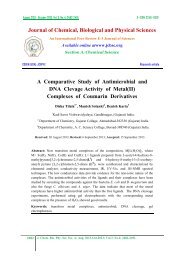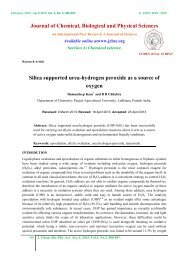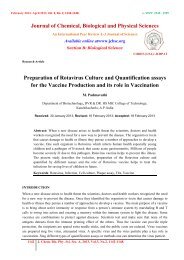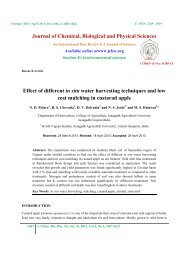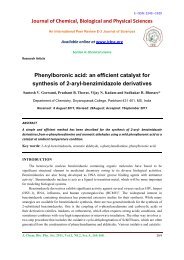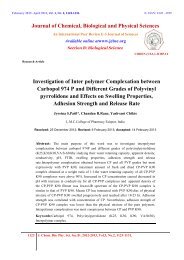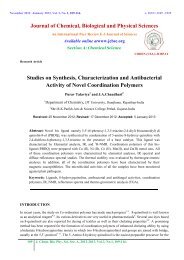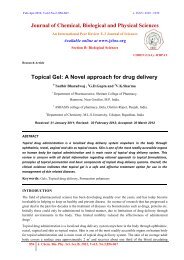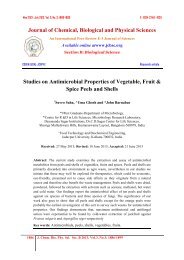Bioactive molecules and their Anti-oxidant activity of Agaricus bisporus
Bioactive molecules and their Anti-oxidant activity of Agaricus bisporus
Bioactive molecules and their Anti-oxidant activity of Agaricus bisporus
- No tags were found...
You also want an ePaper? Increase the reach of your titles
YUMPU automatically turns print PDFs into web optimized ePapers that Google loves.
February 2013- April 2013, Vol. 3, No. 2, 1222-1228. E- ISSN: 2249 –1929Journal <strong>of</strong> Chemical, Biological <strong>and</strong> Physical SciencesAn International Peer Review E-3 Journal <strong>of</strong> SciencesAvailable online atwww.jcbsc.orgSection B: Biological scienceCODEN (USA): JCBPATResearch Article<strong>Bioactive</strong> <strong>molecules</strong> <strong>and</strong> <strong>their</strong> <strong>Anti</strong>-<strong>oxidant</strong> <strong>activity</strong> <strong>of</strong><strong>Agaricus</strong> <strong>bisporus</strong>J.Sankara Rao 1* , K.Ravi Kumar 1 , Venkat Kartheek Vale 1 , Prithvi Prasad Yarlagadda 2,S.Vijaya Saradhi, 21 Division <strong>of</strong> Molecular Biology, Institute <strong>of</strong> Biological Sciences, Vijayawada, Krishna district,Andhra Pradesh, India.2 Department <strong>of</strong> Biotechnology, Koneru Lakshmaiah University, Vaddeswaram, Guntur district,Andhra Pradesh, India.Received: 24 January 2013; Revised: 15 March 2013; Accepted: 25 March 2013Abstract: White button mushroom (species <strong>Agaricus</strong> <strong>bisporus</strong>), cultivation increased throughoutthe world during the last few decades. Its popularity increased due to its ease <strong>of</strong> cultivation, highyield potential <strong>and</strong> high nutritional value. Mycochemical analysis <strong>of</strong> <strong>Agaricus</strong> <strong>bisporus</strong> extractsrevealed the presence <strong>of</strong> terpenoids, tannins, steroidal glycosides <strong>and</strong> carbohydrates. Ethanolicextracts <strong>of</strong> the mushrooms, screened for possible anti<strong>oxidant</strong> <strong>activity</strong> by four complementary testsystems, namely DPPH free radical scavenging, β- carotene/linoleic acid systems, total phenoliccompounds <strong>and</strong> total flavonoid concentration revealed anti<strong>oxidant</strong> <strong>activity</strong> in <strong>Agaricus</strong> <strong>bisporus</strong>.The species are edible <strong>and</strong> can be used as dietary intake for immune enhancement due to <strong>their</strong>anti-<strong>oxidant</strong> <strong>activity</strong>.Keywords: <strong>Agaricus</strong> <strong>bisporus</strong>, anti<strong>oxidant</strong> <strong>activity</strong>INTRODUCTION<strong>Agaricus</strong> <strong>bisporus</strong>, white button mushroom is an edible mushroom <strong>and</strong> is one <strong>of</strong> the most commonly <strong>and</strong>widely consumed mushrooms in the world 1 . <strong>Agaricus</strong> <strong>bisporus</strong> only contains 16 IU <strong>of</strong> vitamin D asergocalciferol (vitamin D2), since they also contain high amounts <strong>of</strong> ergosterol, by brief exposure to UVlight the ergocalciferol contents rise immensely 2 , 3 . <strong>Agaricus</strong> <strong>bisporus</strong> also contains sodium, potassium<strong>and</strong> phosphorus, conjugated linoleic acid4 <strong>and</strong> anti<strong>oxidant</strong>s5. Procatechuric acid <strong>and</strong> pyrocatechol are1222 J. Chem. Bio. Phy. Sci. Sec.B, 2013, Vol.3, No.2, 1222-1228.
<strong>Bioactive</strong> …J.Sankara Rao et al.found in A. <strong>bisporus</strong> 6 . In search <strong>of</strong> new cancer treatments over the past several years, many species <strong>of</strong>basidiomycete mushrooms have been investigated for <strong>their</strong> anti-cancer properties 7 . Lucas 8 , firstdemonstrated the anti-cancer <strong>activity</strong> <strong>of</strong> mushrooms. A 2009 case control study <strong>of</strong> 2,018 womencorrelated a large decrease <strong>of</strong> breast cancer incidence in women who consumed mushrooms. Women inthe study who consumed fresh mushrooms daily were 64% less likely to develop breast cancer, whilethose that combined a mushroom diet with regular green tea consumption reduced <strong>their</strong> risk <strong>of</strong> breastcancer 9 by nearly 90% . The table mushroom also shown to possess possible immune system enhancingproperties 10 , 11 . Many other anticancer compounds <strong>of</strong> mushroom origin, including b-D-glucans,heteropolysaccharides, glycoproteins, lectines, <strong>and</strong> terpenoids have been investigated. Mushroomspossess bioactive <strong>molecules</strong> that act as anti<strong>oxidant</strong> substances <strong>and</strong> prevent the oxidative damage withinthe organism. The present study was taken up to assess the anti<strong>oxidant</strong> property A. <strong>bisporus</strong>.MATERIALS AND METHODSCultures <strong>of</strong> <strong>Agaricus</strong> <strong>bisporus</strong> were procured from Department <strong>of</strong> Horticulture, Andhra Pradesh <strong>and</strong>maintained on 2% agar basidiomycetes synthetic medium (BSM). The composition includes (g l -1 ):glucose (5), K 2 HPO 4 (1), asparagines (0.6) , yeast extract (0.5), KCl(0.5), MgSO 4 .7H 2 O (0.5), FeSO 4(0.1), Mn(CH 3 COO) 2 (0.008), ZnNO 3 (0.003), Ca(NO 3 ) 2 .4 H 2 O (0.006) <strong>and</strong> CuSO 4 .5 H 2 O (0.003) at pH5.5. These cultures were incubated at 28º C in the dark.β-Carotene, linoleic acid, 1,1-Diphenly-2-picrylhydrazyl (DPPH), butylated hydroxytoluene (BHT),butylated hydroxyanisol (BHA) <strong>and</strong> α-tocopherol, were purchased from MERCK India. Pyrocatechole,Tween-20, Folin-ciocalteu’s phenol reagent (FCR), sodium carbonate, ethanol, chlor<strong>of</strong>orm <strong>and</strong> the otherchemicals <strong>and</strong> reagents were purchased from Qualigens, India. All other unlabeled chemicals <strong>and</strong>reagents used were <strong>of</strong> analytical grade.Preparation <strong>of</strong> extracts: Mushrooms cultured in the BSM medium were harvested (150 g) <strong>and</strong> air driedin an oven at 40 o C. A 50 g dried sample was extracted by stirring with 500 ml <strong>of</strong> 70% ethanol at 30 o C at150 rpm for 24 h <strong>and</strong> filtered through Whatman No. 4 filter paper. The residue was re-extracted twice asdescribed above. Combined extracts were rotary evaporated at 40 o C to dryness, redissolved in ethanol(10 mg ml -1 ) <strong>and</strong> stored at 4 o C for further use.Mycochemical analysis <strong>of</strong> <strong>Agaricus</strong> <strong>bisporus</strong>: The mycochemical constituents from the ethanol extracts<strong>of</strong> <strong>Agaricus</strong> <strong>bisporus</strong> were determined qualitatively by thin layer chromatography (TLC) as given byS<strong>of</strong>owora 12 , Trease <strong>and</strong> Evans 13 <strong>and</strong> Harbone 14 . The ethanol extracts were subjected to TLC separationusing butanol- glacial acetic acid-water (100:10:10) solvent system. The developed plates were thensprayed with vanillin solution for steroid detection. The presence <strong>of</strong> carbohydrate was detected byspraying with sodium metaperiodate (0.1%) followed by ethanolic benzidine. Tannins were determinedby the presence <strong>of</strong> brownish green-blue black coloration with 0.1% FeCl 3 Spray. The steroidal glycosideswere determined by Keller-Killani test <strong>and</strong> Cynogenic glycosides were determined by red colourformation in the picrate paper. Flavonoids were detected under UV light <strong>and</strong> the b<strong>and</strong>s should appear inyellowish colour.<strong>Anti</strong><strong>oxidant</strong> <strong>activity</strong> Determination: The anti<strong>oxidant</strong> <strong>activity</strong> was determined by the 2, 2 – diphenylpicryl hydrazyl radical neutralization (DPPH) assay, β- carotene/linoleic acid systems, total phenoliccompounds <strong>and</strong> total flavonoid concentrations.DPPH Assay: Free radical scavenging capacities <strong>of</strong> the extracts (Butylated hydroxy toluene, Butylatedhydroxyanisol, α-tocopherol <strong>of</strong> <strong>Agaricus</strong> <strong>bisporus</strong>) were measured by DPPH assay. One thous<strong>and</strong>1223 J. Chem. Bio. Phy. Sci. Sec. B, 2013, Vol.3, No.2, 1222-1228.
<strong>Bioactive</strong> …J.Sankara Rao et al.microlitres <strong>of</strong> various concentrations <strong>of</strong> the extracts in ethanol were added to 4 ml <strong>of</strong> 0.004% methanolsolution <strong>of</strong> DPPH. Absorbance was read by the formula, against a blank at 517 nm. Inhibition <strong>of</strong> freeradical by DPPH in percent (I %) was calculated in following way. After, 30 min incubation at roomtemperature, absorbance (A) was recorded as (A blank – A sample / A blank) x 100, where A blank isabsorbance <strong>of</strong> the control reaction (all reagents except the test compound), <strong>and</strong> A sample is theabsorbance <strong>of</strong> the test compound. Extract concentration providing 50% inhibition (IC 50 ) was calculatedfrom the plotted graph, inhibition percentage against extract concentration. All the tests were carried outin triplicate 15 , 16 .β-Carotene-linoleic acid Assay: β-Carotene-linoleic acid was determined by measuring the inhibition <strong>of</strong>the volatile organic compounds <strong>and</strong> the conjugated diene hydroperoxides arising from linoleic acidoxidation. Briefly, a stock solution <strong>of</strong> β-carotene-linoleic acid mixture was prepared by dissolving 0.5 mgβ-carotene in 1 ml <strong>of</strong> chlor<strong>of</strong>orm (HPLC grade) <strong>and</strong> adding 25 µl linoleic acid <strong>and</strong> 200 mg <strong>of</strong> Tween 20.Chlor<strong>of</strong>orm was completely evaporated using a vacuum evaporator <strong>and</strong> 100 ml distilled water saturatedwith oxygen (30 min 100 ml/min) was added with vigorous shaking. 4 ml <strong>of</strong> this reaction mixture wasdispensed into test tubes <strong>and</strong> 200 µl <strong>of</strong> the extracts, prepared at 2 mg/l concentrations, were added. Theemulsion system was incubated for 2 h at 50 0 C. The same procedure was repeated with syntheticanti<strong>oxidant</strong>, BHT, BHA, α-toc<strong>of</strong>erol as positive control, <strong>and</strong> a blank. Absorbance <strong>of</strong> the mixtures weremeasured at 490 nm <strong>and</strong> antioxidative capacities <strong>of</strong> the extracts were compared with those <strong>of</strong> BHA, α-toc<strong>of</strong>erol <strong>and</strong> blank 17 at 0.5 mg/mL. The absorbance was measured until the β-carotene colordisappeared. The anti<strong>oxidant</strong> <strong>activity</strong> (AA) was calculated as the percent inhibition (R) relative to thecontrol using Equation. : AA = [(R control − R sample ) /R control ] × 100. The extract concentration providing50% inhibition (IC 50 ) was calculated from the plotted graph, inhibition percentage against extractconcentration. All the tests were carried out in triplicate.Total phenolic Content: Total soluble phenolic compounds in the mushroom ethanolic extracts weredetermined with Folin-Ciocalteu reagent <strong>and</strong> gallic acid as st<strong>and</strong>ard 18 . Extract solution (0.1 ml)containing 1mg extract was taken in a volumetric flask, 46 ml distilled water <strong>and</strong> 1 ml Folin-Ciocalteureagent were added <strong>and</strong> flask was shaken thoroughly. After 3 min, 3 ml <strong>of</strong> solution 2% Na 2 CO 3 wasadded <strong>and</strong> the mixture was allowed to st<strong>and</strong> for 2 h with intermittent shaking. Absorbance was measuredat 760 nm. The same procedure was repeated to all st<strong>and</strong>ard gallic acid solutions (0–1000 mg, 0.1 ml -1 )<strong>and</strong> st<strong>and</strong>ard curve was obtained. Extract concentration providing 50% inhibition (IC 50 ) was calculatedfrom the plotted graph, inhibition percentage against extract concentration. All the tests were carried outin triplicate.Total flavonoid Content: The total flavonoid concentration in mushroom ethanolic extracts wasdetermined by diluting 1 ml extract with 4.3 ml <strong>of</strong> 80% aqueous ethanol in test tubes containing 0.1 ml <strong>of</strong>10% aluminum nitrate <strong>and</strong> 0.1 ml <strong>of</strong> 1 M aqueous potassium acetate. After 40 min at room temperature,the absorbance was determined spectrophotometrically at 415 nm. Total flavonoid concentration wascalculated by the formula, Absorbance = 0.002108 µg quercetin– 0.01089, using quercetin as st<strong>and</strong>ard 19 .Extract concentration providing 50% inhibition (IC 50 ) was calculated from the plotted graph, inhibitionpercentage against extract concentration. All the tests were carried out in triplicate.STATISTICAL ANALYSISAll data are given as Mean ± SD <strong>of</strong> three measurements. Statistical analysis was performed using MSExcel for Windows. The deviation <strong>of</strong> each experimental value was considered significant at P
<strong>Bioactive</strong> …J.Sankara Rao et al.RESULTS AND DISCUSSIONMycochemical analysis <strong>of</strong> ethanol extracts <strong>of</strong> <strong>Agaricus</strong> <strong>bisporus</strong> showed the presence <strong>of</strong> steroids, tannins,steroidal glycosides <strong>and</strong> carbohydrates, but cyanogenic glycosides were absent in the extracts (Table.1).The phenolics <strong>and</strong> flavanoids reported to possess anti<strong>oxidant</strong> <strong>activity</strong> 20 were detected <strong>Agaricus</strong> <strong>bisporus</strong>.Table.1: Comparative analysis <strong>of</strong> Mycochemical constituentsMycochemicalSteroids ++Tannins +Steroidal glycosides +Carbohydrates +Cyanogenic glycosides -Flavonoids +(+): Present; (-) : Absent<strong>Agaricus</strong> <strong>bisporus</strong>The inhibitory concentration (IC 50 ) <strong>of</strong> P. ostreatus was higher in DPPH assay when compared to that <strong>of</strong>P. florida (Table.2). These values for BHT, BHA <strong>and</strong> α-tocopherol were much lower in this assay aswell. The statistical analysis was significant at P
<strong>Bioactive</strong> …J.Sankara Rao et al.The statistical analysis was significant at P
<strong>Bioactive</strong> …J.Sankara Rao et al.REFERENCES1. Cappelli, Alberto . Fungi Europaei:<strong>Agaricus</strong>. Saronno, Italy: Giovanna Biella.1984,. 123–25.2. S.R.Koyyalamudi,S.C. Jeong,C.H. Song,K.Y. Cho, G. Pang, "Vitamin D2 formation <strong>and</strong>bioavailability from <strong>Agaricus</strong> <strong>bisporus</strong> button mushrooms treated with ultravioletirradiation". Journal <strong>of</strong> Agricultural <strong>and</strong> Food Chemistry,2009, 57 (8): 3351–5.3. G.S.Lee,H.S. Byun,K.H. Yoon,J.S. Lee,K.C. Choi,E.B. Jeung, "Dietary calcium <strong>and</strong> vitamin D2supplementation with enhanced Lentinula edodes improves osteoporosis-like symptoms <strong>and</strong>induces duodenal <strong>and</strong> renal active calcium transport gene expression in mice". European Journal<strong>of</strong> Nutrition,2009, 48 (2): 75–83.4. S.Chen,S.R. Oh,S. Phung,G. Hur,J.J. Ye, S.L. Kwok, G.E. Shrode, M. Belury, M et al. "<strong>Anti</strong>aromatase<strong>activity</strong> <strong>of</strong> phytochemicals in white button mushrooms (<strong>Agaricus</strong> <strong>bisporus</strong>)". CancerRes. 2006, 66 (24): 12026–34.5. Y.L.Shi,A.E. James,I.F. Benzie,J.A. Buswell, "Mushroom-derived preparations in the prevention<strong>of</strong> H2O2-induced oxidative damage to cellular DNA". Teratog Carcinog Mutagen ,2002,22 (2):103–11.6. A.Delsignore, F. Romeo, M.Giaccio, "Content <strong>of</strong> phenolic substances inbasidiomycetes". Mycological Research ,1997,101: 552–6.7. Q.Y.Yang, <strong>and</strong> S.C.Jong, Medicinal mushrooms in China. Mushr. Sci.1989, 9, 631-643.8. E.H.Lucas, Tumor inhibitors in Boletus edulis <strong>and</strong> other Holobasidiomycetes. <strong>Anti</strong>biot.Chemotherapy, 1957,7, 1-4.9. M.Zhang, J. Huang, X. Xie, C.D. Holman, "Dietary intakes <strong>of</strong> mushrooms <strong>and</strong> green tea combineto reduce the risk <strong>of</strong> breast cancer in Chinese women".International Journal <strong>of</strong>Cancer ,2009,124 (6): 1404–1408.10. Z.Ren,Z. Guo,S.N. Meydani,D. Wu, "White button mushroom enhances maturation <strong>of</strong> bonemarrow-derived dendritic cells <strong>and</strong> <strong>their</strong> antigen presenting function in mice". J.Nutr.2008,138 (3): 544–50.11. D.Wu,M. Pae,Z. Ren,Z. Guo,D. Smith,S.N. Meydani , "Dietary supplementation with whitebutton mushroom enhances natural killer cell <strong>activity</strong> in C57BL/6 mice". J. Nutr. 2007,137 (6):1472–7.12. A.S<strong>of</strong>owora,. Medicinal plants <strong>and</strong> Traditional medicine in Africa. Spectrum Books. Ltd. Ibadan,Nigeria,1993, 270-289.13. G.Trease <strong>and</strong> W.C.Evans, Pharmacognosy. 11th edn. Brailliar Tiridel. Can. Macmillianpublishers,1989.14. J.B.Harbone , Phytochemical methods. London. Chapman <strong>and</strong> Hall. Ltd. 1973,15. M.Burits <strong>and</strong> F.Bucar, <strong>Anti</strong><strong>oxidant</strong> <strong>activity</strong> <strong>of</strong> Nigella sativa essential oil. Phytother Res. 2000;14: 323-08.16. M.K.Cuendet,K. Hostettmann <strong>and</strong> O.Potterat, Iridoid glucosides with free radical scavengingproperties from Fragarea blumei. Helvetica Chimica Acta, 1997, 80:1144-1152.17. A.Dapkevicius,R. Venskutonis,T.A. Van Beek <strong>and</strong> P.H.Linssen, <strong>Anti</strong><strong>oxidant</strong> <strong>activity</strong> <strong>of</strong> extractsobtained by different isolation procedures from some aromatic herbs grown in Lithuania. J. Sci.Food <strong>and</strong> Agric, 1998, 77:140-146.18. K.Slinkard <strong>and</strong> V.L.Singleton, Total phenol analyses: automation <strong>and</strong> comparison with manualmethods, American J. Enolo. Viticul, 1977, 28: 49–55.19. Y.K.Park,M.H. Koo,M. Ikegaki <strong>and</strong> J.L.Contado, Comparison <strong>of</strong> the flavonoid aglycone contents<strong>of</strong> Apis mellifera propolis from various regions <strong>of</strong> Brazil, Arquivos de Biologiae Techno,1997, 40(1): 97-106.20. R.A.A.Mothana,R. Jansen,W.D. Julich <strong>and</strong> U.Lindequist, Ganomycin A <strong>and</strong> B, new antimicrobialfarnesyl hydroquinones from the basidiomycete Ganoderma pfifferi. Journal <strong>of</strong> NaturalProducts,2000, 63(3): 416-418.1227 J. Chem. Bio. Phy. Sci. Sec. B, 2013, Vol.3, No.2, 1222-1228.
<strong>Bioactive</strong> …J.Sankara Rao et al.21. P.Jayakumar,N. Jothivel,A. Thimmappa <strong>and</strong> Paul VI , Physicochemical characterisation <strong>of</strong> alentic water body from Tamil Nadu with special reference to its pollution status. TheEcoscan.2009, 3(1<strong>and</strong>2): 59-64.22. Türkoğlua Aziz, Mehmet Emin Duru <strong>and</strong> Nazime Mercan,<strong>Anti</strong><strong>oxidant</strong> <strong>and</strong> <strong>Anti</strong>microbial Activity<strong>of</strong> Russula delica Fr: An Edidle Wild Mushroom, Eurasian Journal <strong>of</strong> Analytical Chemistry,2007,2(1).23. J.K.S.Moller,H.L. Madsen,T. Altonen <strong>and</strong> L.H. Skibsted, Origanum dictamnus as a source <strong>of</strong>water-extractable anti<strong>oxidant</strong>s. Food Chem.1999, 64: 215–219.24. T.Hatano,R. Edamatsu,A. Mori,Y. Fujita, <strong>and</strong> E.Yasuhara, Effect <strong>of</strong> interaction <strong>of</strong> tannins withco-existing substances. VI. Effects <strong>of</strong> tannins <strong>and</strong> related polyphenols 1989.25. A.Cakir,M.A. Ahmet Yıldırım,M.E. Duru,M. Harm<strong>and</strong>ar <strong>and</strong> C. Kazaz, Isolation <strong>and</strong>Characterization <strong>of</strong> anti<strong>oxidant</strong> Phenolic Compounds From the Aerial Parts <strong>of</strong> Hypericumhyssopifolium L. by <strong>activity</strong>-guided Fractionation., J Ethnophar.2003, 87: 73-83.26. P.D.Duh,Y.Y. Tu <strong>and</strong> G.C.Yen, <strong>Anti</strong><strong>oxidant</strong> <strong>activity</strong> <strong>of</strong> water extracts <strong>of</strong> harn jyurChyrsanthemum morifolium (Ramat). Lebensmittel-Wissenschaft und Technologie1999,32:269–277.27. M.Tanaka,C.W. Kuei,Y. Nagashima <strong>and</strong> T.Taguchi, Application <strong>of</strong> antioxidative maillradreaction products from histidine <strong>and</strong> glucose to sardine products. Nippon Suisan Gakkaishil,1998, 54: 1409-1414.28. A.M.Murcia,M. Martinez-Tome, A.M. Jimenez,A.M. Vera,M. Honrubia <strong>and</strong> P.Parras ,<strong>Anti</strong><strong>oxidant</strong> <strong>activity</strong> <strong>of</strong> edible fungi (truffles <strong>and</strong> mushrooms): Losses during industrialprocessing. Journal <strong>of</strong> Food Protection,2002, 65, 1614−1622.29. C.A.Rice-Evans,N.J. Miller,Paganga,. Structure-anti<strong>oxidant</strong> <strong>activity</strong> relationships <strong>of</strong> flavonoids<strong>and</strong> phenolic acids. Free Radic. Biol. Med.,1996, 20: 933-956.30. C.Manach,A. Scalbert,C. Mor<strong>and</strong>,C. Remesy,L. Jimenez, Polyphenols: Food sources <strong>and</strong>bioavailability. Am. J. Clin. Nutr. ,2004,79: 727747.31. S.Z.Dziedzic <strong>and</strong> B.J.F.Hudson, Hydroxy is<strong>of</strong>lavones as anti<strong>oxidant</strong>s for edible oils. FoodChemistry ,1993,11: 161-166.32. Ratty AK, Das NP. Effects <strong>of</strong> flavonoids on non enzymatic lipid peroxidation: structure-<strong>activity</strong>relationship. Biochem Med Metab Biol. 1988 Feb;39(1):69-7933. Y.Hanasaki,S. Ogawa,S. Fukui, The correlation between active oxygens scavenging <strong>and</strong>antioxidative effects <strong>of</strong> flavonoids. Free Radic. Biol. Med.,1994, 16:845-850.34. K.Nakamura,R. Kawashima,M. Sugiura,T. Kato,A. Nakamura,K. Hatano,S. Nagumo,K.Kubota,H. Fukuda,K. Ito,S. Kojima, Neural substrates for recognition <strong>of</strong> familiar voices: a PETstudy. Neuropsychologia,2001, 39. 1047– 1054.Corresponding author J.Sankara Rao; Division <strong>of</strong> Molecular Biology, Institute <strong>of</strong> BiologicalSciences, Vijayawada, Krishna district, Andhra Pradesh, India – 520 1001228 J. Chem. Bio. Phy. Sci. Sec. B, 2013, Vol.3, No.2, 1222-1228.



